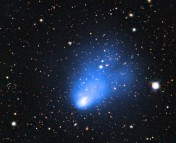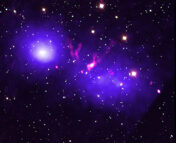Paper title: EVOLUTION OF THE MERGER INDUCED HYDROSTATIC MASS BIAS IN GALAXY CLUSTERS
Authors: Kaylea Nelson, Douglas H. Rudd, Laurie Shaw, Daisuke Nagai
First Author’s Affiliation: Yale University
Introduction:
The largest known gravitationally bound structures in the universe are galaxy groups and clusters. These giant structures trace the matter density of the universe, and by counting clusters as a function of mass and redshift, cosmologists can learn about the expansion rate of the Universe. However, it is difficult to accurately measure the total mass of a cluster, limiting the power of cluster number count methods.
This paper describes two methods in particular to determine cluster mass: measuring X-ray and Sunyaev-Zel’dovich (SZ) emission (check out this post about the SZ effect). With X-ray and SZ observations, one can measure the density and temperature of the hot plasma called the intra-cluster medium (ICM) which fills the cluster environment in between the member galaxies. The thermal properties of the ICM are sensitive to gravitational potential, and hence cluster mass.
These measurements depend on solving the equation of hydrostatic equilibrium (HSE), assuming that the ICM is spherically symmetric. However, assumptions of HSE and spherical symmetry are likely too simplistic, since clusters are very active and young systems, continually obtaining more mass through mergers. A better understanding of the bulk motions within clusters is important for obtaining more accurate mass estimates.
The accuracy of a cluster mass estimate is characterized by a quantity called the “mass bias”, which is the difference in the true mass of a cluster and the mass estimated using the HSE technique. The goal of this paper is to investigate how the mass bias changes as a result of major mergers of galaxies within a cluster.
Method:
The authors analyzed 16 simulated galaxy clusters using a code called the Adaptive Refinement Tree (ART) N-body+gas-dynamics code (more on N-body simulations here). Discrete particles represent dark matter, and the code follows these as they move among the simulated grid of particles which make up the clusters. An example of one of the simulated clusters is shown in the figure below (Figure 1 in the paper).

Thermal pressure maps of a single galaxy cluster over time. The panels are centered on the most massive dark matter halo in the cluster. Two clusters begin merging in frame (b), a shock is shown with the red dashed line in frame (d), and the cluster has relaxed in frame (f).
What happens over time in the cluster? The simulation tracks the cluster’s most bound dark matter particles, considered to be the “most massive progenitor” of each cluster. On occasion, collections of gravitationally-bound dark matter particles, or halos, will merge to form a more massive progenitor, which is then tracked by the simulation.
General trends:
With the simulated clusters, the authors can measure the mass of the ICM by assuming spherical symmetry and solving the equation of HSE — this is called the HSE mass. Since the clusters are simulated, the authors know exactly how much mass was “put in”, and therefore know the “true mass” of the cluster. They compare the true mass profiles (mass as a function of radius) with the mass predicted from the equation of HSE.
The authors find that the mass biases at the start and end states of the simulated clusters are qualitatively similar, but the mass bias changes during a merger, with the HSE mass under-estimating the true mass. This evolution in the mass bias can signify approximately how much time has passed since a major merger, and split a sample of galaxy closets into “relaxed” and “unrelaxed”.
In addition, the authors investigate the evolution of the non-thermal pressure support (from bulk motions, not from cosmic rays, magnetic fields, nor turbulence). The HSE mass calculation only uses thermal pressure, which is the origin of the mass bias in the first place. Therefore, what is novel about this paper is the calculation of the mass taking into account both the thermal and non-thermal pressure support. Using this corrected mass estimate, the authors recover the true mass of the system in the “relaxed” clusters, but fail for the unrelaxed clusters because those clusters are not in equilibrium.




